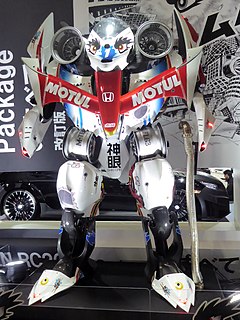
The term mecha may refer to both scientific ideas and science-fiction genres that center on giant robots or machines (mechs) controlled by people. Mechas are typically depicted as humanoid walking vehicles. The term was first used in Japanese: 'mecha', after shortening the English loanword 'mechanism' or 'mechanical', but the meaning in Japanese is more inclusive, and 'robot' or 'giant robot' is the narrower term.
United States Special Operations Forces (SOF) are the special forces of the United States Department of Defense's United States Special Operations Command (USSOCOM) within the United States Armed Forces, used for special operations.
The Interceptor Multi-Threat Body Armor System (IBA) is a bullet-resistant body armor system that was used by the United States Armed Forces during the 2000s, with some limited usage into the mid-2010s. IBA and its design replaced the older standardized fragmentation protective Personnel Armor System for Ground Troops (PASGT) body armor system that was designed in the late 1970s and introduced in the early 1980s.

Personnel Armor System for Ground Troops is a combat helmet and ballistic vest that was used by the United States military from the early 1980s until the mid-2000s, when the helmet and vest were succeeded by the Lightweight Helmet (LWH), Modular Integrated Communications Helmet (MICH), and Interceptor Body Armor (IBA) respectively.
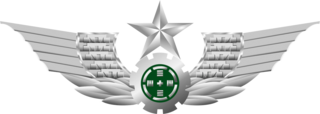
The People's Liberation Army Ground Force is the land-based service branch of the People's Liberation Army and the largest and oldest branch of the entire Chinese armed forces. The PLAGF can trace its lineage from 1927 as the Chinese Red Army; however, it was not officially established until 1948.

The FNSCAR is a family of gas-operated automatic rifles developed by Belgian manufacturer FN Herstal (FN) in 2004. It is constructed with modularity for the United States Special Operations Command (SOCOM) to satisfy the requirements of the SCAR competition. This family of rifles consist of two main types. The SCAR-L, for "light", is chambered in 5.56×45mm NATO and the SCAR-H, for "heavy", is chambered in 7.62×51mm NATO. Both are available in Close Quarters Combat (CQC), Standard (STD), and Long Barrel (LB) variants.
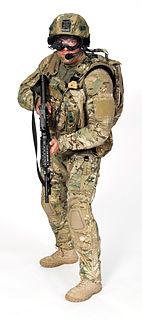
Future Force Warrior was a United States military advanced technology demonstration project that was part of the Future Combat Systems project. The FFW project sought to create a lightweight, fully integrated infantryman combat system. It was one technology demonstration project in a series of network-centric, next-generation infantry combat projects the U.S. military have developed over the past decade, such as the Soldier Integrated Protective Ensemble technology demonstration program, Land Warrior, and Transformation of the United States Army.
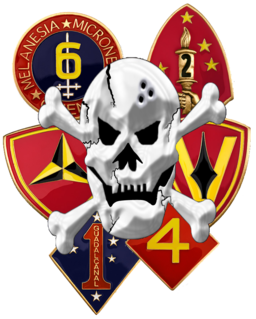
The United States Marine Corps Reconnaissance Battalions are the Special Operations Capable reconnaissance assets of Marine Air-Ground Task Force that provide division-level ground and amphibious reconnaissance to the Ground Combat Element within the United States Marine Corps. Division reconnaissance teams are employed to observe and report on enemy activity and other information of military significance in close operations. The Military Occupational Specialty code for Reconnaissance Marine is 0321.

The Modular Integrated Communications Helmet (MICH) is a U.S. combat helmet and one of several used by the U.S. military. It was developed by the United States Army Soldier Systems Center to be the next generation of protective combat helmets for use by the U.S. Army.
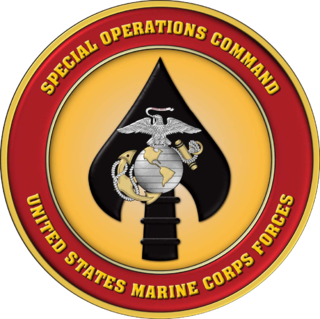
United States Marine Forces Special Operations Command (MARSOC) is a component command of the United States Special Operations Command (SOCOM) that comprises the Marine Corps' contribution to SOCOM. Its core capabilities are direct action, special reconnaissance and foreign internal defense. MARSOC has also been directed to conduct counter-terrorism and information operations.

The BOV, is an all-wheel drive armoured vehicle manufactured in the former Yugoslavia and today in Serbia. The second generation BOV is currently in development.
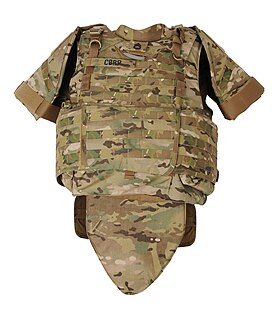
The Improved Outer Tactical Vest (IOTV) is an enhanced version of, and a replacement for, the older Outer Tactical Vest (OTV) variant of the Interceptor Body Armor, as fielded by the United States Army. The IOTV is compatible with the Deltoid and Auxiliary Protector System (DAPS) components, ESAPI, Enhanced Side Ballistic Inserts (ESBI), as well as the OTV's groin protector. It has a flame-resistant stand-alone shirt known as the Army Combat Shirt designed specifically for use with the IOTV.

Human Universal Load Carrier, or HULC, is an un-tethered, hydraulic-powered anthropomorphic exoskeleton developed by Professor H. Kazerooni and his team at Ekso Bionics. It is intended to help soldiers in combat carry a load of up to 200 pounds at a top speed of 10 miles per hour for extended periods of time. After being under development at Berkeley Robotics and Human Engineering Laboratory since 2000, the system was announced publicly at the AUSA Winter Symposium on February 26, 2009 when an exclusive licensing agreement was reached with Lockheed Martin. Although the exoskeleton is powered and can be used, the project was a failure as it hindered certain movements and actually increased strain on muscles, going directly against what a powered exoskeleton is supposed to do.
The Modular Body Armor Vest (MBAV) is a bullet-proof vest made by Eagle Industries and used by the United States military. The vest is standard issue for many members of the United States special operations forces including the 75th Ranger Regiment. 10,000 vests were deployed on an interim basis with the U.S. Marine Corps while it developed the Scalable Plate Carrier. The vest was also evaluated by the U.S. Army.

A powered exoskeleton is a wearable mobile machine that is powered by a system of electric motors, pneumatics, levers, hydraulics, or a combination of technologies that allow for limb movement with increased strength and endurance. Its design aims to provide back support, sense the user's motion, and send a signal to motors which manage the gears. The exoskeleton supports the shoulder, waist and thigh, and assists movement for lifting and holding heavy items, while lowering back stress.

The Ground Mobility Vehicle (GMV) is a U.S. Special Operations Command, (US)SOCOM program, initially modifying Humvees into several variants for use by the United States special operations forces (SOF).
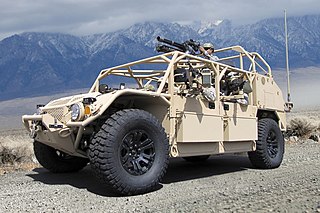
The Flyer Advanced Light Strike Vehicle platform has been developed by General Dynamics Ordnance and Tactical Systems (GD-OTS), in partnership with Flyer Defense LLC, for the U.S. Special Operations Command (SOCOM) Ground Mobility Vehicle Program. The Flyer Advanced Light Strike Vehicle platform configurations are the Flyer 72 and the narrower Flyer 60.

Ratnik is a Russian future infantry combat system. It is designed to improve the connectivity and combat effectiveness of combat personnel in the Russian Armed Forces. Improvements include modernised body armour, a helmet with a special eye monitor, communication systems, and special headphones. It includes 10 subsystems and 59 individual items. As of October 2016, it has already seen combat use.

The United States Special Operations Command is the unified combatant command charged with overseeing the various special operations component commands of the Army, Marine Corps, Navy, and Air Force of the United States Armed Forces. The command is part of the Department of Defense and is the only unified combatant command created by an Act of Congress. USSOCOM is headquartered at MacDill Air Force Base in Tampa, Florida.















